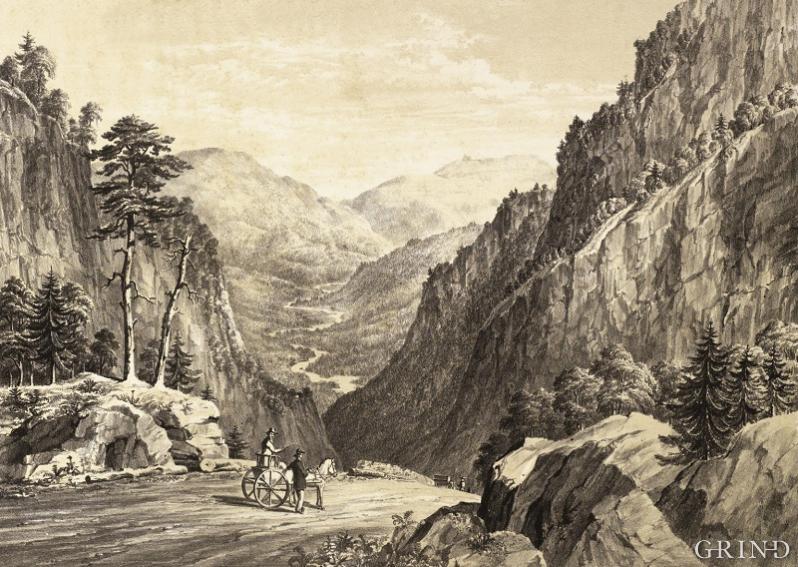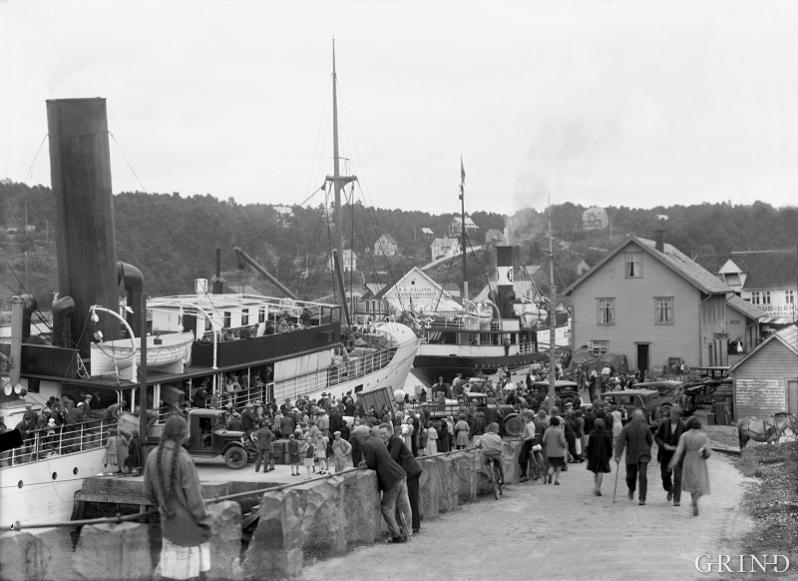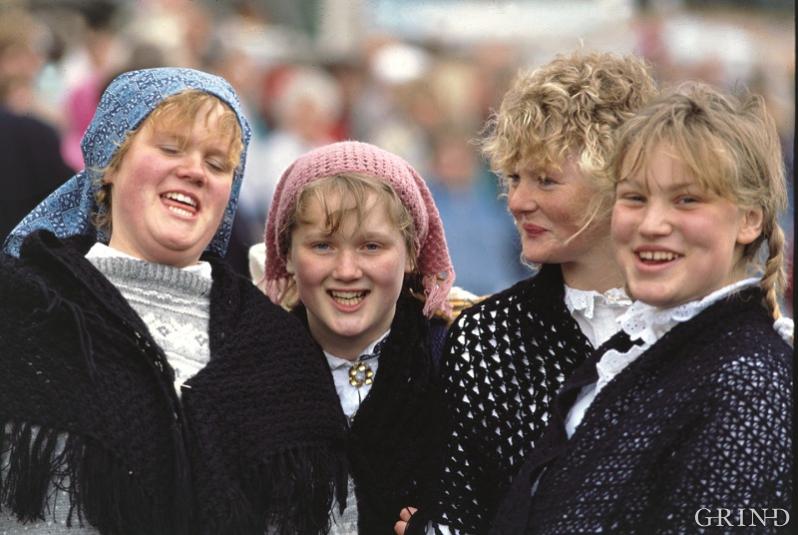Published: 19.05.2009 | Author: Helge Sandøy
The language is shaped in daily life – out in the great “language laboratory”. (Viggo Agdestein).
Language tells us both about social distance and human contact in many different ways. The dialects show how people who have had connections and dealings with one another throughout the ages, have developed a common language. Thus the geography of our dialects tell us of our cultural history - with evidence from the oldest settlements to the migrations which took place in the 20th century, when our new industrial centres were built. The similarities and differences in the local Hordaland dialects can thus be interpreted as evidence for contact within the county and routes of communication outside Hordaland. The Bergen dialect is distinguished by exhibiting international contacts right back to the Middle Ages and the Hanseatic period. The so-called “burr” (or uvular ‘r’ sound) is also of international origin. It is claimed that this had its origins in the speech impediment of a French king. This spread from the court in Paris along the international lines of communication to Copenhagen in the 18th century and a little later on to Bergen. The rapid spread of the burr today in Hordaland is an expression of how contacts and lines of communications operate in our times.
Four Hordaland dialects
It is natural to distinguish four separate dialects in Hordaland. Some of the contacts between the Hordaland dialects can be summarised as in the following four variants of a sentence which in English means: “The purse-seiners could not find the herring.
Snurparana kunne ikkje fidna sildæ (the dialect of Nordhordland)
Snurparane konde ikkje finna sildæ (the dialect of Voss and Hardanger)
Snurparadne kionde ikkje finna sildo (the dialect of Sunnhordland)
Snurparene kunne ikkje finne si’l (the Bergen dialect)
Even in a short sentence we can see that the differences can be relatively large - within a relatively limited geographical area. Since similarities and differences within a language often reflect cultural contacts - or lack of contacts - the language can tell us indirectly how good the contacts have been between different parts of the county down the ages. It is also quite clear from what we know of our linguistic history, that scarcely any of these differences are more than 700 years old. Where there are similarities however, these can be older. We should not exaggerate the differences, even although it is these which one notices most easily in detailed study. We shall soon see that the dialects are in fact closely related.
Common features of the Hordaland dialects
We shall take up the problem with calling the Bergen dialect a Hordaland dialect at a later stage. In the rural dialect of Hordaland county, we consider that the “a -” dialect is the most important common feature, that is to say that the infinitives and the weak feminine gender (in the singular indefinite article) ends in the letter –a., as occurs in the verb: å visa and in the noun ei visa. These are features of southwest Norway which we find from Sogn in the north to Lista in the south.
Throughout the whole county one has had forms like fjedl, kadla, bjødn and kådn for several centuries. Here in the first case is the older ll sound, that is a long l sound, which has gone over to become two sounds: dl. In the other case it is the older conjunction of consonants rn which has been changed to dn. These two developments in sounds cover the larger part of southwest Norway. Whilst the a-dialect was an original feature from the Old Norse times, in addition we have two new features which bear witness to an old association within a greater southwest Norway area. We also find the development from rn to dn in the adjacent mountain districts in Valdres and Hallingdal which in their time came under the Gulating (the local regional Parliament). We must reckon that both the linguistic similarities and this ancient judicial boundary arose from a close cultural association.
We can also say that the use of the pronoun me had a uniting effect; but in the same way as above, that this special characteristic covered a much larger area than simply the county itself. Most west Norwegian dialects and upland dialects retain this form of pronoun. (We will mention the exceptions with vi: Bergen, Rosendal with neighbouring settlements, Askøy and parts of Sotra).
“Aokans baot and dekans aora”
Different wovels
The first thing that we perhaps notice when we hear people from the different rural districts are the changing diphthongs. The diphthongs ei and øy which we know from the written language in Voss and Hardanger were pronounced as ai and åy: bain and håy. But the same two areas also have a diphtong where others have the monophthong å, as, in example baot: “Aokans baot og dekans aora” (our boat and your oars). These diphthongs are most pronounced amongst people from Voss and Hardanger, but also amongst people from Sogn.'
The dialects in Hardanger and Voss are very similar, so that we can reckon these two dialect regions as one. Inner Hardanger in particular has many peculiarities together with Voss. This is the case for the Voss “o”, this peculiar vowel which is attached to the adjective and to the present tense of a strong verb, and which in addition is used as a plural ending (the indefinite form) of weak feminine nouns: jildo, kjemmo, jento etc.
Such an additional vowel at the end of an adjective and the present tense of a strong verb (and the verb in the telja class) is to be found throughout most of western Norway. The terminal vowel –e as in jílde and kjemme is usual outside Voss and Inner Hardanger. But Nordhordland differs totally in that those words do not have any ending at all, and so are simply: jill and kjemm
The divisions within the Hordaland dialects demonstrate links with the outside
Different consonants
In the example of the word jill we see at the same time another peculiar feature of the Nordhordland dialect. It has a so-called assimilation between ld and nd, that is that the pronunciation of sild and sand is sill and sann. These assimilations also occur in the Bergen dialect. Otherwise in Hordaland and the west of Norway pronunciation is unassimilated.
Nordhordland perhaps distinguishes itself most in the way it handles the consonants. Whilst the whole county has got dl for ll, a smaller part of the Nordhordland dialect has also got dl for the older ld, that is to say that the ld went over at any early stage to ll. Thus in such dialects one finds forms like kvèdl and fjèdl. Other places in Nordhordland the words are kvèll and fjèdl, and otherwise in the county the forms are kvèld and fjèdl.
A parallel peculiarity with the “power centre” in Nordhordland is the development of nn to dn and mm to bm; kudna for kunna and kåbma for komma, etc. We can also find these forms in a large part of Sunnhordland.
We can mention yet another peculiarity which distinguishes between rural dialects, but which is not clear between the traditional regions. Sunnhordland and Hardanger have vn where New Norwegian uses mn; navn, havn etc. We find this also today in the Voss dialect, but in the old Voss dialect the pronunciation with bn was used: nabn, habn. This demonstrated a relationship with the Sogn dialect which is not unnatural from a geographical point of view. In Nordhordland the bn pronunciation has probably been even stronger, but in more recent dialects it appears that it has given way to a pronunciation with mn; namn, hamn etc. This latter feature points northwards to the dialects in Outer Sogn and the Fjords, that is the coastal areas to the north.
Hestana and visena (Horses and songs)
Different endings
Another “external phenomenon” is –a as a terminal vowel in the plural definite article in both the masculine and feminine forms. On the southern coastal stretch of Nordhordland and the northern coastal stretch of Sunnhordland, for example, Sotra and Austevoll, people say hestana (horses) and visena (songs). Elsewhere in Nordhordland the endings are -ane and -ena, that is that the first vowel determines the last one. In Voss the system is more complicated which we can see from the forms of hestane, sekkjene, solena, myrane visona. Here we can see that endings in the masculine nouns always end in –e.
We come across even more variations in endings in Sunnhordland. In the southern part the words are hestadne, sekkjedne etc. These districts have the transition to dn in common with the dialects in Ryfylke (to the south of Hordaland). But the most common one in Sunnhordland is the system we find in the written language, that is –ane and –ene.
Thus we continue to see how the county boundaries do not always correspond to the dialect boundaries. Communications with Ryfylke have clearly been good for a long time. This is probably the reason that the –å (an open o) ending in the feminine noun is steadily spreading further north today in Sunnhordland. There all the feminine nouns have the same ending in the definite singular form, that is –o; solo, bokjo, viso. In the remainder of the county the feminine nouns are divided in such a way that the strong ones get an –æ and the weak ones get –o: solæ, bokjæ, but viso. (those that do not have an ending in the indefinite form are strong; sol, bok etc.).
We shall go no further in dividing up the county; if we had room it would be possible to find dialect boundaries between most of the rural districts. But it has emerged that that which separates the rural districts of Hordaland indicates old links with rural districts outside the county boundaries. Within the county the language can broadly be divided into three areas; Nordhordland, Sunnhordland and Voss with Hardanger. In Hardanger the Hardanger Fjord has served to link districts on both sides of the fjord. But outside the fjord area, the differences become greater, and there we go over into the dialect of Sunnhordland. The links between the coastal districts have naturally been considerable because of the fishing industry. This has certainly played a part in the fact that the differences between the Sunnhordland dialect and the Nordhordland dialect are not so great.
The Bergen dialect
If we proceed on purely linguistic grounds, we cannot call the language of Bergen a Hordaland dialect. The Bergen dialect is an e- dialect while the dialect of the rural districts of Hordaland is an a- dialect. Thus in Bergen one says “å vise” (to show) and “en vise” (a song). We have to go to the country far to the north, around Ålesund to find a similar example, and we cannot dismiss the possibility that one of the explanations for this phenomenon can be a major migration from that area.
Many people have toyed with the origins of the Bergen dialect. The special peculiarities point to an ancient origin, and it is clear that Bergen has developed its own urban dialect as early as the Middle Ages. The city was established in the territory of Nordhordland, and it is possible to interpret some parts of the Bergen dialect as originally from Nordhordland. Perhaps this is true for the assimilations from ld to ll and from nd to nn. But otherwise this urban dialect exhibits similarities with all the rural dialects around for example in words like eg, meg, nåkke, mykkje, ikkje, vatn, båtn etc.
The main feature of the Bergen dialect the “single gender” probably developed during the Middle Ages, so that the conjugation of the masculine and feminine nouns has been reduced to one conjugation: en sak – saken is thus the same as en labb – labben. From a linguistic point of view this could have most easily occurred as early as the Middle Ages. In addition it is easiest to comprehend such a basic change in terms of a very major inward migration, and most probably by foreigners with another language. Within an environment with considerable linguistic mixing we know that dialects with a degree of grammatical simplification can emerge. It is this that has probably happened with the conjugation of nouns in the Bergen dialect. The Bergen dialect is the only one in Norway exhibiting this feature.
Perhaps the special past tense forms in the verb in the kasta (to throw) class are equally old: kastet, har kastet etc. In the Bergen dialect this is a domestic development in the dialect and not a normalisation from the standard written Norwegian.
Developments today
There is probably not much wrong in saying that the “burr” entered the Bergen dialect around 1800. But of course such a new sound had not been fully incorporated before several generations had passed. But the Bergen dialect was the first with it. After that came Odda and Sørfjorden; there the “burr” turned up around 1900. In that year the doctor Christian Vidsteen wrote that the r sound had smitten the inhabitants of Leirvik on Stord. “The whole of the growing youth of the resort of Leirvik in Stord has seemingly been smitten by the numerous city folk here in the summer, with the same grating “burr” sound, frequently to the great annoyance of their parents”. Today the “burr” sound has reached the whole of the younger generation of Sunnhordland and Hardanger. Voss to some extent has also been “infected”. The greatest opposition has been in Nordhordland, but today we can see that the front line has also been broken there too. It is not too daring to say that this “burr” sound will have conquered the whole county within a generation or two.
During the 20th century several urban settlements have grown up, the older ones based on industry and tourism, the younger ones based on administration. When population growth is rapid and large these new settlements become exciting laboratories for new dialects. And the new dialect in one settlement is important if we want to look into the future, because these settlements function as a centre for their regions, and the central dialect has a great influence on the dialects around.
We can assert without doubt that the a- ending in the infinitive and the weak feminine noun are the peculiarities which will remain most stable. Words containing dn and dl, on the other hand, will give way to words containing rn and ll.
If we use Odda as the starting point for the Hardanger region, we should assume that the diphthong -ao will disappear, whilst -ai, -åy and the divided conjugation of strong and weak feminine nouns will remain, perhaps with the endings -a and -o: as in sola and viso. Experience from the urban settlements in Sunnhordland shows that the present tense in a strong verb will miss out the vowel shift in the infinitive, so that for the older såva – søve one now gets å såva – såve. In Voss the -ao diphthong probably also disappears, as does the vowel ending -o in the present tense of the strong verb and in the adjective, so that these forms come to sound like the forms from Nordhordland: kjèmm, søv, kvit, jild etc.
Those who come after us will be able to study these development tendencies as expressions of the cultural and identity creation links which arose in the 20th century.
- Rundhovde, G. (1976) Målføra eller dialektane i Hordalandsbygdene og i Bergen by. I: Hartvedt, G. H. red. Hordaland og Bergen. Bygd og by i Norge. Oslo, Gyldendal, s. 394-408.
- Sandøy, H. (1990) Vestlandet - der fjordane batt folk saman. I: Jahr, E. H. red. Den store dialektboka. Oslo, Novus, s. 63-88.










